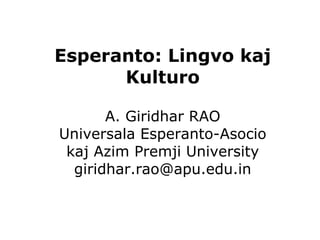
Esperanto: Language and Culture
- 1. Esperanto: Lingvo kaj Kulturo A. Giridhar RAO Universala Esperanto-Asocio kaj Azim Premji University giridhar.rao@apu.edu.in
- 2. Esperanto? What? Planned language for international communication Why? Easy to learn And? Not the cultural property of any nation or group: humanity's “common resource”
- 3. Esperanto – How does it sound? Mia nomo estas Giridhar. Mi estas en Bengaluro. Bengaluro estas la ĉefurbo de la landparto Karnataka. Karnataka estas en suda Barato. Barato estas granda lando en la kontinento Azio.
- 4. Why Esperanto? - 1 English, French, Chinese, Hindi, Telugu... take too long to learn! Being forced to master someone else's language is unfair. We need a more even playing-field: linguistic democracy.
- 5. Why Esperanto? - 2 Esperanto - is an easy, “open-source”, democratic solution - helps in learning other languages faster - promotes global citizenship - a tool for peace-building
- 6. What is Esperanto? Planned language for international communication Easy to learn Not the cultural property of any nation or group
- 7. Lejzer Ludwik ZAMENHOF (1859-1917)
- 8. Zamenhof's Esperanto - 1 Russian, Polish, German (fluently); Yiddish, French, Hebrew, Greek, Latin, English (less well). Some knowledge of Spanish, Lithuanian and Volapük 26 July 1887 La Unua Libro – 127 years Some original poetry Translated Old Testament, Hamlet, Goethe, Heine, Schiller, Gogol
- 9. Zamenhof's Esperanto - 2 Volapük? Johann Martin SCHLEYER So, Esperanto was not the first planned language? Certainly not! Over a 1000 such projects through human history!
- 10. Planned Languages - A Aawaaniaan, Acian, Adelfiy, Adelic, Adinjo, Aduna lingvo, Aeldarspragc (Dale Morris), Aelya (C. Moreland- Stringham), Aeo (Jonathana Tegire), Aertran (A. B. Basham), Afga, Aftesalono, Ahua (R. K.), Akbiekdi, Alarian, Aldana (R. D. Cooper), Alevain (Sydney Mathew Willoughby), Alesi, Allmiror, Almalinian, Almaqerin, Alpha Smart, Alphistian, Altayko, Aluric, Alzetjan (H. Miller), Amaringa, Amaubo, Amelic, Ámman-Iâr, Amtorian, Andan, Ande, Anawanda, Aninese, Antelangua, Arcaicam Esperantom, Arden, Arkian, Arumo (lingvo), Ascian, Asiteya, Assi (P. Pfeaster), Astegonagraphianek, Atlanteano, Atlo-Greka, Aulingese, Auxilingua (J. Bowks, 1979) (Bazita sur Interlingua), Auxilia, (G. Morin, 1947) Ayeis (http://eo.wikipedia.org/wiki/Listo_de_planlingvoj)
- 11. What is Esperanto? Planned language for international communication Easy to learn Not the cultural property of any nation or group
- 12. Esperanto: the affixes - 1 Ĉevalo (= Horse / Stallion ) Ĉevalino ( = Mare ) Ĉevalido ( = Foal / Colt ) Ĉevalidino ( = Filly ) Ĉevalejo ( = Stable ) Ĉevala ( = Horse-like / Equine )
- 13. Esperanto: la afiksoj - 2
- 14. Esperanto: la afiksoj - 3 Arbo = a tree + -ar- = a group of things - Arbaro = a forest (vort-ar-o; hom-ar-o) Skribi = to write + -aĵ- = something concrete; something tangible - Skribaĵo = some writing; something written -il- = a tool; Skribilo = a pen; Skribilaro = stationery, a bunch of things you need to write with, paper, pens, erasers, etc.
- 15. Esperanto: the affixes - 4 -ej- = a place; Skribejo = a room where we sit and write; Skribilejo = a room where you keep pens -ist- = a professional; Skribisto = a professional writer, a scribe Skribilisto = someone who professionally makes or sells pens Skribilaristo = a stationery producer or seller
- 16. Esperanto: the affixes - 5 Ino (female), Ido (child), Aro (set), Ilo (tool), Ejo (place), Isto (professional) – words in themselves; lexical affixes Thus: inismo (feminism); ilaro (tool-kit) Highly productive derivational morphology; intensively agglutinating Result: in John Wells' Eo-En / En-Eo dict. (2010), 10 315 entries in Eo; 22 300 in En
- 17. Why Esperanto? - 1 English, French, Chinese, Hindi, Telugu... take too long to learn! Esperanto? How long?
- 18. Why Esperanto? - 1 Basic French? Basic German? 100-200 hours of classes (+ homework!) Basic Esperanto? 40 hours max!
- 19. Why Esperanto? - 2 School English? 10 000–15 000 hours of learning! – Nursery + LKG + UKG + Class 1-10 = 13 years – 5 hours every day x 200 days per year = 1000 hours per year of English – Nursery to Class 10 = 13 000 hours of English
- 20. Esperanto: the community - 1 Guestimate: About 100 000 active speakers (Factoid: half the world's 7000 lang. have less than 7000 speakers! Mean = 886k) Universala Esperanto-Asocio (Rotterdam): 18 000 members in 111 countries (previous prezidanto: Probal Dasgupta, Kolkato, Barato)
- 21. Esperanto: the community - 2 ~ 200 families where Esperanto is one of the home languages 150-200 books every year Esperanto Wikipedia: > 201 000 articles; with ~ 12 000 hits per hour! 100a Universala Kongreso en Lillo, Francio Online communities
- 22. What is Esperanto? Planned language for international communication Easy to learn Not the cultural property of any nation or group
- 23. Esperanto: Ideology - 1 Praga manifesto (1996) Linguistic democracy Transnational education Pedagogical efficiency
- 24. Esperanto: Ideology - 2 Multilingualism Linguistic rights Linguistic diversity Human emancipation
- 25. How to learn Esperanto Free Esperanto courses (in > 41 languages!) at WWW.LERNU.NET
- 26. Esperanto: the flavour Soneto 18 de Ŝekspiro (Tr. Reto Rosetti) Ĉu mi komparu vin al tag' somera? Vi estas ja pli bela kaj serena Majflorojn ofte vipas vent' severa Kaj tro maldaŭras la somero bena. Jen brulas la okulo de l'ĉielo Jen vualiĝas ĝia vido ora Kaj iam senbeliĝas ĉiu belo Laŭ voj' natura aŭ pro fat' rigora Sed jam ne velkos via plensomero Nek dekliniĝos de l'beleco nuna La morto vin ne tenos kun fiero Se vin la vers' eterna gardas juna. Dum homoj spiros kaj okuloj vidos Vivante en vivanta vers' vi sidos.